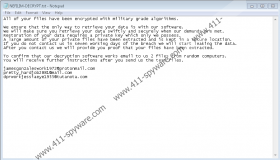NEFILIM Ransomware Removal Guide
NEFILIM Ransomware could be on your system if your files cannot be opened and are marked with .NEFILIM extension, e.g., oranges.jpg.NEFILIM. Also, victims of this malicious application should notice a text file called NEFILIM-DECRYPT.txt on their computers. According to the message inside of this document, victims of the malware must do what they are told if they want to decrypt files that have the mentioned extension and to keep their data private. However, our specialists advise not to make any rash decisions and learn more about the malware before you decide what you should do. If you think it would be the smartest to get to know it too, we encourage you to read our full report. Also, we can offer our deletion instructions that explain how you could remove NEFILIM Ransomware manually if it stays on your system after it encrypts your files.
NEFILIM Ransomware could be sent to victims via spam emails or its creators might spread it through malicious file-sharing web pages. Thus, we recommend opening email attachments or links in messages only if you are one hundred percent sure that they are harmless. Besides, it would be best to download software only from legitimate websites. What’s more, the threat could enter a system by exploiting its weaknesses like unsecured RDP (Remote Desktop Protocol) connections or outdated software. Consequently, it would be a good idea to take care of such vulnerabilities if your computer has them.
Research shows that NEFILIM Ransomware does not need to create any files upon entering a system. Therefore, it might start the encryption process shortly after it gets in. Our specialists say that since the malware might work silently in the background, its victims might not notice it until it finishes encrypting their files. After the encryption process, users should not only notice that their files have the .NEFILIM extension but also that it is impossible to access them. Moreover, victims ought to find text files called NEFILIM-DECRYPT.txt in all directories that contain encrypted data. Opening them should show a message from the malicious application’s developers. To be more precise, it ought to say that hackers can decrypt files, but they will only do so if users get in touch with them. For this reason, the message ought to show a few email addresses.
To convince users to contact them, NEFILIM Ransomware’s creators might say in their message that they have copied various private files and that they will leak them. No doubt, users who have personal files or data carrying sensitive information on their computers might get scared and decide to do as told. The reason why we recommend against it is because you might be asked to pay ransom if you contact the malware’s creators. The worst part is that you cannot be certain that hackers will hold on to their end of the bargain, which means you could lose your money in vain.
Whatever it is that you decide to do about the hackers’ demands, we advise deleting NEFILIM Ransomware from your device. Our researchers say that their tested sample erased itself automatically after it encrypted files, but we cannot know for sure that all of the threat’s versions will do the same. For this reason, we advise trying to remove NEFILIM Ransomware while following the instructions located below or with a reliable antimalware tool of your choice.
Get rid of NEFILIM Ransomware
- Click Ctrl+Alt+Delete.
- Pick Task Manager and go to the Processes tab.
- Check if there is a process belonging to the malicious application.
- Select it and press the End Task button.
- Close Task Manager.
- Press Win+E.
- Go to the paths:
%USERPROFILE%\Desktop
%USERPROFILE%\Downloads
%TEMP% - Look for a recently obtained file that might have infected your device, right-click it, and choose Delete.
- Find files named NEFILIM-DECRYPT.txt, right-click them, and choose Delete.
- Close File Explorer.
- Empty Recycle Bin.
- Reboot the computer.
NEFILIM Ransomware Screenshots:


